Book-6-Unit-2语言点复习教学教材
Book6-unit2-poems-reading诗歌

Say Goodbye to Cambridge Again
Very quietly I take my leave As quietly as I came here; Quietly I wave good-bye To the rosy clouds in the western sky.
Find the rhyme(押韵) of this poem.
Nursery rhyme(童谣)
Hush, little baby, don’t say a wwoorrdd, Papa’s going to buy you a mmoocckkiinnggbbiirrdd.
If that mockingbird won’t ssiinngg, Papa’s going to buy you a diamond rriningg.
[a:s]
[əu]
If that billy-goat runs away,
Papa is going to buy you another ttooddaayy.
[ei]
Para.3. Read para.3 carefully and answer the questions.
1.What kind of poem are mentioned in this paragraph?
PoemD
兄弟
Brother Beautiful ,athletic
爱美,爱运动
Teasing, shouting ,laughing 爱闹,爱叫,又爱笑
Friend and enemy too 是我的朋友
mine
也是我的敌人
夏天 困乏,咸涩
人教PEP版六年级英语上册《Unit2》精品教案教学设计小学优秀公开课8

人教PEP版六年级英语上册第二单元教案Unit2Ways to go to school教学设计二、呈现(Presentatio n)1.main scene学习(1)呈现图片,仔细观察图片,回答问题,Where are they?What can you see?(2)学生仔细观察图片,展开合理想象并回答老师的问题。
Where are they?What can you see?(3)听录音,模仿朗读,理解对话内容。
①指明朗读对话,并翻译主要句子的中文意思,掌握单词、句子的读法。
2教师领读对话,学生模仿,齐读,生生对话,小组表演。
3告诉学生应该遵守交通规则,红灯停,绿灯行。
2.学习Let’s try&Let’s talk(1)T:Today I come to school on bus.Iusually come to school on foot.Whatabout you?Do you come by bike or bybus?Do you come on foot or by car?(2)Listen to the tape(3)快速反应游戏:教师说出某个短语,让学生做相应的动作并说出句子(4)听录音,跟读Let’s talk内容,注意纠正学生的发音(5)图片解释usually/often/sometimes单词的区别。
(100%80%60%40%0)(6)同桌表演对话,培养学生学习语言,课堂上激发学生不断地去说,再引入课文内容的学习。
1、free talk形式,先跟学生展开对话,让学生在学习新内容前先巩固已学过的知识。
2、通过听、游戏、动作去了解短文意思,并通过学习,引出频率副词的学习,让学生自然而然地掌握,了解所发生频率不一样,需要用不同的频率副词。
三、操练(Practice )1.Listen to the tape.Listen to the tape and read after it.2.Play a chain game教师做动作,自问自答:How doI come to school?I come to school by bike,继续重复刚才的句子并问某一位学生,继续传递下去。
人教英语精通版六年级上册_Unit2_lesson12_公开课教案【内蒙古包头】

Unit2 lesson12 公开课教案【内蒙古包头】授课教师:沙河第六小学石明丽【目标确定的依据】1. 课程标准相关要求。
能在教师的帮助下简单介绍自己。
能在具体语境中进行交流表达自己的观点。
在词语和相应事物之间建立联想。
乐于感知并积极尝试使用英语。
2. 教材与学情分析。
本节课的教学内容是人民教育出版社精通版教材六年级上册第一和第二单元综合复习课。
这两个单元学习了有关日常生活和爱好的话题。
本节双单元复习课的功能是在理解并熟练认知课本内容的基础上,继续巩固复现两个单元所学习的日常生活及爱好的核心句型“What do you do on Saturdays? I often go and see a film. What’s your hobby? My hobby is collecting maps/ stamps/ picture cards/toy cars. 及其单三人称的交流:She gets up at 6:00. Then she cooks breakfast. She goes to school at 7:00.What’s your dad’s/ mum’s/grandpa’s/grandma’s hobby?His/ Her hobby is cooking/planting flowers/fishing/ singing/drinking tea.What are you interested in? I’m interested in making dolls/ playing computer games/ taking photos.”本次执教的班级为沙河一小六年级的学生。
他们从已经学了三年多的英语,有相当扎实的英语语言综合运用能力。
刚刚学习过的第一二单元是有关日常生活和爱好的话题,贴近生活实际,学生感兴趣,也有话可说。
三年级时已经学过家庭成员的表达,四年级时学过职业类的词汇,五年级时已经学习过描述人物个性和一些动词短语,加上六年级一二单元的学习认知,学生能够更加精细地对人物进行描述和交流。
高中英语 Book6unit2课件 人教新目标版选修6
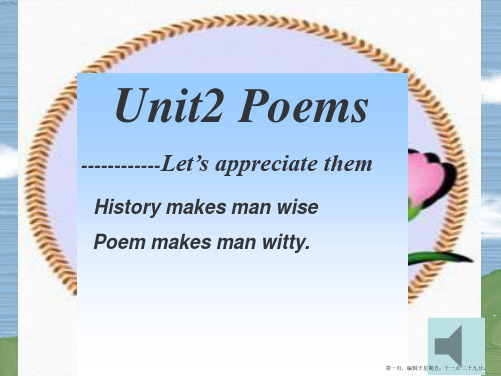
第十四页,编辑于星期五:十一点 二十九分。
• Task 4: Appreciate cinquain and
practice writing one.
第十五页,编辑于星期五:十一点 二十九分。
Let’s appreciate the works of students
第二十一页,编辑于星期五:十一点 二十九分。
Task 6: Appreciate some haiku
A Rainbow Donna Brock Curving up, then down. Meeting blue sky and green earth Melding〔合并〕 sun and rain.
“paint〞 a mental image (映象)in
the reader's mind. The most common form for Haiku is three short lines. The first line usually contains five (5) syllables, the
第二十二页,编辑于星期五:十一点 二十九分。
• Task 7: • Enjoy the English poems and
appreciate them.
第二十三页,编辑于星期五:十一点 二十九分。
•
Dreams by L. Hughes
ቤተ መጻሕፍቲ ባይዱ
• Hold fast to dreams 将梦想握紧别放
•
War
•
by Song Ting
war
•
sad destructive
•
killing injuring destructing
Unit2TheuniversallanguageExtendedreading教案-高中英语译林版
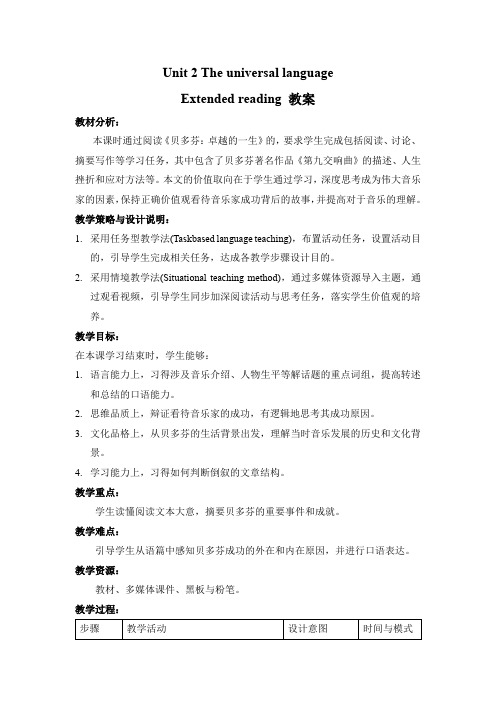
Unit 2 The universal languageExtended reading 教案教材分析:本课时通过阅读《贝多芬:卓越的一生》的,要求学生完成包括阅读、讨论、摘要写作等学习任务,其中包含了贝多芬著名作品《第九交响曲》的描述、人生挫折和应对方法等。
本文的价值取向在于学生通过学习,深度思考成为伟大音乐家的因素,保持正确价值观看待音乐家成功背后的故事,并提高对于音乐的理解。
教学策略与设计说明:1.采用任务型教学法(Taskbased language teaching),布置活动任务,设置活动目的,引导学生完成相关任务,达成各教学步骤设计目的。
2.采用情境教学法(Situational teaching method),通过多媒体资源导入主题,通过观看视频,引导学生同步加深阅读活动与思考任务,落实学生价值观的培养。
教学目标:在本课学习结束时,学生能够:1.语言能力上,习得涉及音乐介绍、人物生平等解话题的重点词组,提高转述和总结的口语能力。
2.思维品质上,辩证看待音乐家的成功,有逻辑地思考其成功原因。
3.文化品格上,从贝多芬的生活背景出发,理解当时音乐发展的历史和文化背景。
4.学习能力上,习得如何判断倒叙的文章结构。
教学重点:学生读懂阅读文本大意,摘要贝多芬的重要事件和成就。
教学难点:引导学生从语篇中感知贝多芬成功的外在和内在原因,并进行口语表达。
教学资源:教材、多媒体课件、黑板与粉笔。
教学过程:Leadin:T asks Ss to list famous pianist they know.[T displays some picture and name of pianist according to their birth year. If possible, T could tell a little bit about their master pieces or achievement.] T asks: Do you know anything about Beethoven?[T can display the picture of Beethoven, and give some tips to remind Ss to recall memories.]Reading (fast reading):T asks some question about main events in Beethoven’s life. T shows them according to the ages of him.Q1: What was the audience’s response to Beethoven’s live performance? [T refers the sentences from the article and makes Ss feel the real situation. If possible, T can play a video to show the reaction from audiences at the end of live show of Symphony No.9]Q2: How do you think Beethoven felt seeing the audience’s response?[T encourage Ss to use imagination to guess the reaction of Beethoven based on their understanding of his personality and experience.]Q3: What helped Beethoven build up a reputation as a wonderful young musician?[T encourages Ss to answer the question from internal and external factors linking to the details in article for preparing discussion questions.]article?[T shows the mind to organize the main idea for each paragraph. Then, T asks Ss to concentrate on the different content between first para and following content. Next, T teaches the flashback writing skill. If possible, T can play the opening of Forrest Gump, which is a typical flashback for making Ss understand the skill visually.]Q2: What was the biggest problem Beethoven faced in his life? How did he try to overe this problem?[T refers the sentence from the article, and introduces the idea of bone conduction. Then, T can ask one more question to make Ss understand Beethoven’s personality and feelings.]Q3: Can you briefly introduce Beethoven’s Symphony No. 9 usingthe information in the article? [Before discussing the question, T can play short piece from the each movement and lead Ss to reread the description from the article and tell how they feel]Finally, T can asks: Why does the author choose Symphony No. 9 as the string of the whole passage? For making Ss understand the importance of masterpiece for a musician.备注:Ss: Students T: TeacherIW: Individual work GW: Group work CW: Class work教学反思:1.学生通过本课时学习,能否理解阅读文本主要内容,并能逻辑清晰地梳理出文章大意与主要结构。
洪恩英语第六册教案2
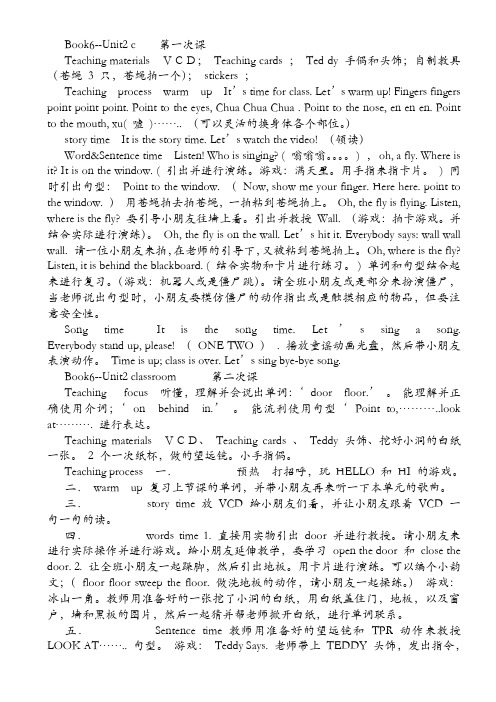
Book6--Unit2 c 第一次课Teaching materials VCD;Teaching cards ;Ted dy 手偶和头饰;自制教具(苍蝇3 只,苍蝇拍一个);stickers ;Teaching process warm up It’s time for class. Let’s warm up! Fingers fingers point point point. Point to the eyes, Chua Chua Chua . Point to the nose, en en en. Point to the mouth, xu( 嘘)…….. (可以灵活的换身体各个部位。
)story time It is the story time. Let’s watch the video! (领读)Word&Sentence time Listen! Who is singing? ( 嗡嗡嗡。
) ,oh, a fly. Where is it? It is on the window. ( 引出并进行演练。
游戏:满天星。
用手指来指卡片。
) 同时引出句型:Point to the window. (Now, show me your finger. Here here. point to the window. )用苍蝇拍去拍苍蝇,一拍粘到苍蝇拍上。
Oh, the fly is flying. Listen, where is the fly? 要引导小朋友往墙上看。
引出并教授Wall. (游戏:拍卡游戏。
并结合实际进行演练)。
Oh, the fly is on the wall. Let’s hit it. Everybody says: wall wall wall. 请一位小朋友来拍,在老师的引导下,又被粘到苍蝇拍上。
Oh, where is the fly? Listen, it is behind the blackboard. ( 结合实物和卡片进行练习。
Module6-Unit-2-I-haven't-got-a-book-about-the-US课件

Miss Lin,my Art teacher, helped me make a poster of New York with those photos.
3.When does your school start and finish,Lingling?
The head
Thank you for your letter.I’m happy to be your pen friend.
I haven’t got a book TabhoauntkthyeoUuSf.Borut..I..h..ave got some photos of New York.Daming sent them to me.Miss Lin,my Art teacher,
The Empire State Building
the UN building 联合国大厦
U:United 联合的 N:Nations 国家
The UN wants to make peace in the world.
和平
Statue of Liberty自由女神像
2.Who helped Lingling make a poster of New York?
Module 6 Unit 2 I haven’t got a book about the US.
(1) 在看、听、说的活动中,学会在语境中运用表示自己或 他 人 没 有 此 物 , 但 有 彼 物 的 句 型 : I haven't got a book about the US,but I’ve got…
1.What have you got,Lingling?
六年级上册英语教案-Unit2 (Lesson9) |人教精通版

Lesson9 教学设计与反思一、教材分析本课是人民教育出版社《小学英语精通版》六年级上册Unit2 What’s your hobby? Lesson 9。
主要谈论的话题是Jim家人的兴趣爱好。
本课是这个单元的第三课时,话题是hobbies,学生学习表示兴趣爱好的动词短语fishing, planting flowers, drinking Chinese tea, cooking, singing,并根据相应的兴趣爱好进行适当的评价,同时学生会运用句型What’s your…’s hobby? His/Her hobby is…询问和介绍他人的兴趣爱好。
二、学情分析本节课授课对象是六年级学生,学生通过三年的学习积累,已经掌握了一定的表达兴趣爱好的词汇,例如dancing, singing, playing football等等,对于介绍自己的兴趣爱好的句型I like…I’m interested in…也能够正确进行表达。
学生已能用功能句型I like…向他人介绍自己的兴趣爱好。
这些都为本课将要学习的hobbies话题奠定了基础。
通过三年的学习,学生已初步形成了良好的学习习惯,对英语有了浓厚的兴趣,能够通过对本课的学习,就“兴趣爱好”这一话题进行简单描述,学生已经初步具有了理解、认读和口语表达的能力,并初步具有自主学习和小组合作的意识和能力。
三、教学目标知识目标:熟练掌握本节课出现的新单词和句型,紧紧围绕“兴趣爱好”这一话题准确、流畅地开展语言交流活动。
能力目标:学生在真实的语境中,运用本课所学的语言知识并结合学生已有生活经验,学习并使用询问并描述他人的兴趣爱好。
情感目标:1、从学生生活实际出发,创设贴近学生生活的情境,吸引和调动学生的积极性,使之敢于开口说英语、运用英语,积极参与,主动请教,让学生体验学习的快乐和成功的喜悦。
2、学生通过对Jim各家庭成员的爱好描述,让学生学会接受和欣赏他人的兴趣爱好,并培养有益健康的兴趣和爱好。
仁爱版英语七年级下Unit6 Topic2教学设计
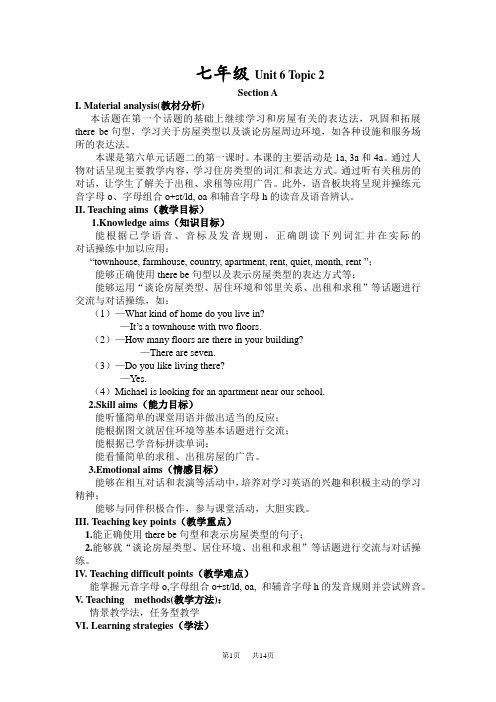
七年级Unit 6 Topic 2Section AI. Material analysis(教材分析)本话题在第一个话题的基础上继续学习和房屋有关的表达法,巩固和拓展there be句型,学习关于房屋类型以及谈论房屋周边环境,如各种设施和服务场所的表达法。
本课是第六单元话题二的第一课时。
本课的主要活动是1a, 3a和4a。
通过人物对话呈现主要教学内容,学习住房类型的词汇和表达方式。
通过听有关租房的对话,让学生了解关于出租、求租等应用广告。
此外,语音板块将呈现并操练元音字母o、字母组合o+st/ld, oa和辅音字母h的读音及语音辨认。
II. Teaching aims(教学目标)1.Knowledge aims(知识目标)能根据已学语音、音标及发音规则,正确朗读下列词汇并在实际的对话操练中加以应用:“townhouse, farmhouse, country, apartment, rent, quiet, month, rent ”;能够正确使用there be句型以及表示房屋类型的表达方式等;能够运用“谈论房屋类型、居住环境和邻里关系、出租和求租”等话题进行交流与对话操练,如:(1)—What kind of home do you live in?—It’s a townhouse with two floors.(2)—How many floors are there in your building?—There are seven.(3)—Do you like living there?—Yes.(4)Michael is looking for an apartment near our school.2.Skill aims(能力目标)能听懂简单的课堂用语并做出适当的反应;能根据图文就居住环境等基本话题进行交流;能根据已学音标拼读单词;能看懂简单的求租、出租房屋的广告。
3.Emotional aims(情感目标)能够在相互对话和表演等活动中,培养对学习英语的兴趣和积极主动的学习精神;能够与同伴积极合作,参与课堂活动,大胆实践。
Module6 Unit 2 I haven’t got a book about the US教案
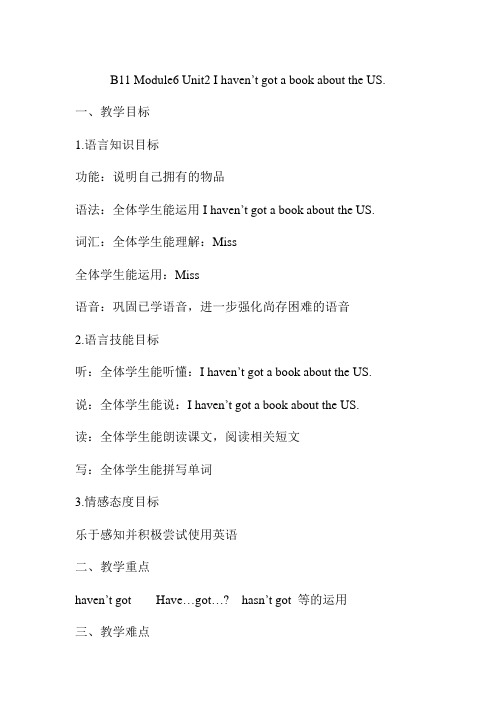
B11 Module6 Unit2 I haven’t got a book about the US.一、教学目标1.语言知识目标功能:说明自己拥有的物品语法:全体学生能运用I haven’t got a book about the US. 词汇:全体学生能理解:Miss全体学生能运用:Miss语音:巩固已学语音,进一步强化尚存困难的语音2.语言技能目标听:全体学生能听懂:I haven’t got a book about the US. 说:全体学生能说:I haven’t got a book about the US. 读:全体学生能朗读课文,阅读相关短文写:全体学生能拼写单词3.情感态度目标乐于感知并积极尝试使用英语二、教学重点haven’t got Have…got…? hasn’t got 等的运用三、教学难点分辨have 和has 的使用四、教学过程Step1. Revision and lead- in:1.Greetings2.Teacher draw some pictures and teach the time.1)Ask and answer. What’s the time? It’s……2)listen and point.3) pair work and show the results.Step2. Task-PresentationT:What have Daming and Simon got?Let’s see.Listen and answer.Then repeat.T: Today our task is to talk about what you have got. How to talk about? Now let’s learn Module 6 Unit 2.Step3. Text-teachingThe teacher draw a picture and have them guess.T: What’s this in English?Ss: It’s a building.Ss: It’s a school.T: Yes, it’s a school. So what time does your school start and w hat time does your school finish?S1: It starts at nine o’clock.S2:It starts at eight past fifty.S3: It finishes at five o’clock.2. Listen and answer the questionsa. Lingling has got a ……b. Lingling hasn’t got a…..c. What time does school start?d. What time does school finish?3. Listen and repeat.4. Read the text.Step 4 Practice:1.The teacher show some pictures man or woman and ask:a. What’s your name?b. Where do you live?c. What do you like?d. What don’t you like?e. What have you got?2. Ask and answer.3. Let the students make a chant.4. Read the chant.5. Try to show the results.Step 5. Task- completionWrite a letter to Laura.1.write by themselves2.choose two students to readmunicate in groupsStep 6. Summary and homeworkModule 6 Unit 2I haven’t got a book about the US.My school starts at eight o’ clock.What time does your school start and finish?。
六年级英语上册Unit2知识点
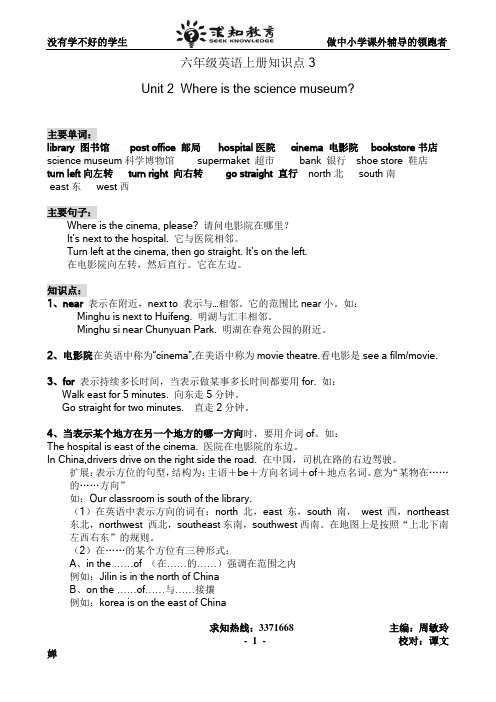
六年级英语上册知识点3Unit 2 Where is the science museum?主要单词:library 图书馆post office 邮局hospital医院cinema 电影院bookstore书店science museum科学博物馆supermaket 超市bank 银行shoe store 鞋店turn left向左转turn right 向右转go straight 直行 north北south南east东west西主要句子:Where is the cinema, please? 请问电影院在哪里?It’s next to the hospital. 它与医院相邻。
Turn left at the cinema, then go straight. It’s on the left.在电影院向左转,然后直行。
它在左边。
知识点:1、near 表示在附近,next to 表示与…相邻。
它的范围比near小。
如:Minghu is next to Huifeng. 明湖与汇丰相邻。
Minghu si near Chunyuan Park. 明湖在春苑公园的附近。
2、电影院在英语中称为“cinema”,在美语中称为movie theatre.看电影是see a film/movie.3、for表示持续多长时间,当表示做某事多长时间都要用for. 如:Walk east for 5 minutes. 向东走5分钟。
Go straight for two minutes. 直走2分钟。
4、当表示某个地方在另一个地方的哪一方向时,要用介词of。
如:The hospital is east of the cinema. 医院在电影院的东边。
In China,drivers drive on the right side the road. 在中国,司机在路的右边驾驶。
扩展:表示方位的句型,结构为:主语+be+方向名词+of+地点名词。
六年级上册英语Unit2教案(冀教版)
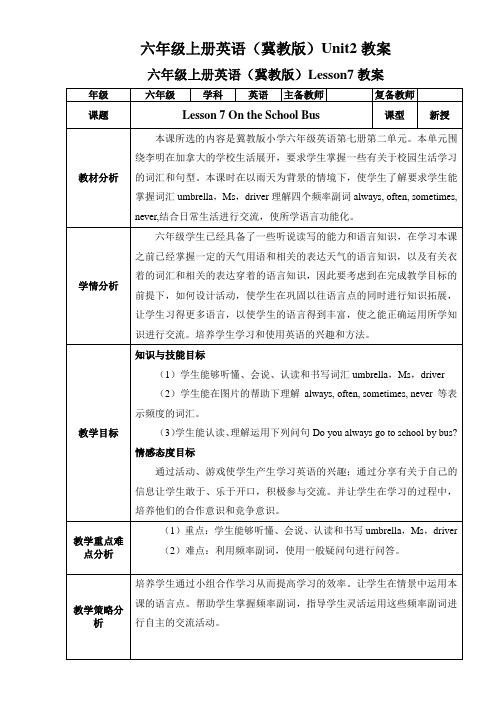
六年级上册英语(冀教版)Unit2教案六年级上册英语(冀教版)Lesson7教案day?(2)引导学生在图中找到公交车站,了解有关信息。
What is this?Here is the bus stop. What can we see at the bus stop?T: Let’s get on the school bus.通过猜测职业来教授bus driverDo you know the woman?Is she a teacher/…?Pair work:Discuss in pairsShe is a bus driver.Do you know her name? 了解Ms一词极其读音3、Let’s Practice!Finish Part 3.4、Always, Often, Sometimes, Never (1)always--neverAre you a bus driver? When do you go to school?How do you go to school?引导学生提问出示表格,I go to school by car.教授单词alwaysT: So I can say I always go to school by car.Do you always go to school by car?分组跟读句子,记忆问答,操练巩固教授单词never S: It’s a bus stop.A bus./A school bus.No!学生进行积极地讨论学生在逐步理解中明白了Ms. Scott的信息。
学生根据所学新知进行练习巩固No. I’m a student.I go to school fromMonday to Friday.I go to school …学生组织语言提问:How do you go to school?学生根据表格表象进行理解。
学生跟读、记忆Yes. /No. I always go toschool by…学生小组问答Do you always go toschool by car?Yes. /No. I always go toschool by…学生根据所给信息练习句型。
外研版八年级英语下册 module6 unit2教案 (1)
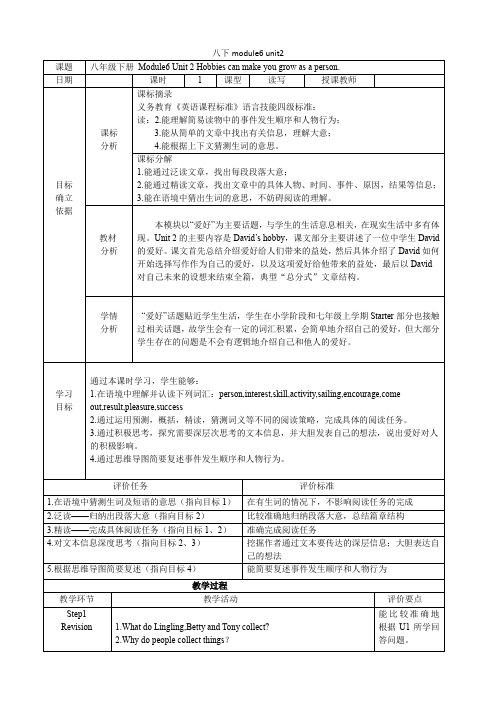
4.能在教师的帮助下或以小组讨论的方式起草和修改作文。
课标分解 1.能通过变式朗读,连贯流畅地朗读课文; 2.能通过两人对话,就“hobby” 这一话题进行交谈; 3.能运用所学语言点的和文章结构,仿写作文。
张蕊
教材 分析
本模块以“爱好”为主要话题,与学生的生活息息相关,在现实生活中多有体 现。Unit 2 的主要内容是 David’s hobby,课文部分主要讲述了一位中学生 David 的爱好。课文首先总结介绍爱好给人们带来的益处,然后具体介绍了 David 如何 开始选择写作作为自己的爱好,以及这项爱好给他带来的益处,最后以 David 对自己未来的设想来结束全篇,典型“总分式”的文章结构。
能大胆发表自 己的观点。
In 2010
He spent four weeks at a ____.There was a writing class.
His teacher______ him to write about their experiences at the camp.
Step6
Back at school
hard work
experience future plan
Step10
How to develop our hobbies?
Show a video
Homework
1. Read aloud the new words and phrases. 2. Read aloud the passage. 3. Share your hobbies with your classmates.
学情 分析
“爱好”话题贴近学生生活,学生在小学阶段和七年级上学期 Starter 部分也 接触过相关话题,故学生会有一定的词汇积累,会简单地介绍自己的爱好,但 部分学生存在的问题是不会有逻辑地介绍自己和他人的爱好。
人教版英语book6unit2poems--writeacinquain教学设计
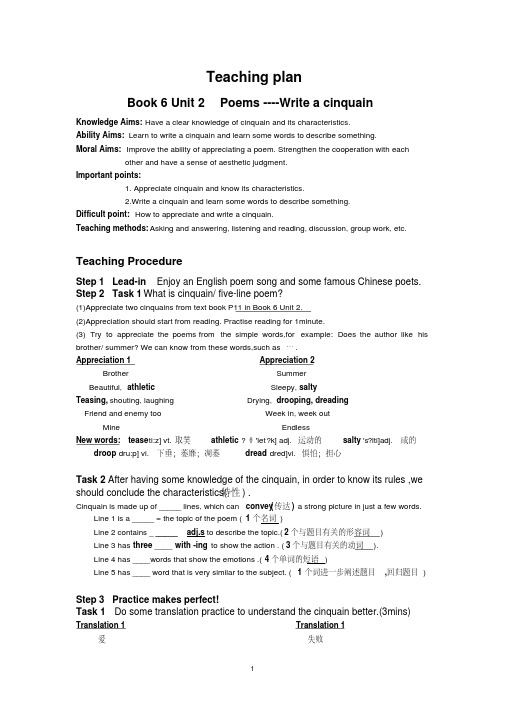
Teaching planBook 6 Unit 2 Poems ----Write a cinquainKnowledge Aims: Have a clear knowledge of cinquain and its characteristics.Ability Aims: Learn to write a cinquain and learn some words to describe something.Moral Aims: Improve the ability of appreciating a poem. Strengthen the cooperation with each other and have a sense of aesthetic judgment.Important points:1. Appreciate cinquain and know its characteristics.2.Write a cinquain and learn some words to describe something.Difficult point: How to appreciate and write a cinquain.Teaching methods: Asking and answering, listening and reading, discussion, group work, etc.Teaching ProcedureStep 1 Lead-in Enjoy an English poem song and some famous Chinese poets. Step 2 Task 1 What is cinquain/ five-line poem?(1)Appreciate two cinquains from text book P11 in Book 6 Unit 2.(2)Appreciation should start from reading. Practise reading for 1minute.(3) Try to appreciate the poems from the simple words,for example: Does the author like his brother/ summer? We can know from these words,such as ….Appreciation 1 Appreciation 2Brother SummerBeautiful, athletic Sleepy, saltyTeasing, shouting, laughing Drying, drooping, dreading Friend and enemy too Week in, week outMine EndlessNew words:tease ti:z] vt.取笑athletic ?θ'let?k] adj. 运动的salty 's?lti]adj. 咸的droop dru:p] vi. 下垂;萎靡;凋萎dread dred]vi. 惧怕;担心Task 2 After having some knowledge of the cinquain, in order to know its rules ,we should conclude the characteristics(特性) .Cinquain is made up of _____ lines, which can convey(传达) a strong picture in just a few words.Line 1 is a _____ = the topic of the poem (1个名词)Line 2 contains ______ adj.s to describe the topic.(2个与题目有关的形容词)Line 3 has three ____ with -ing to show the action . (3个与题目有关的动词).Line 4 has ____words that show the emotions .(4个单词的短语)Line 5 has ____ word that is very similar to the subject. (1个词进一步阐述题目,回归题目)Step 3 Practice makes perfect!Task 1Do some translation practice to understand the cinquain better.(3mins) Translation 1 Translation 1爱失败1。
外研版(三起)-英语-六年级下册--外研版三起Module 6 Unit 2教材同步讲解
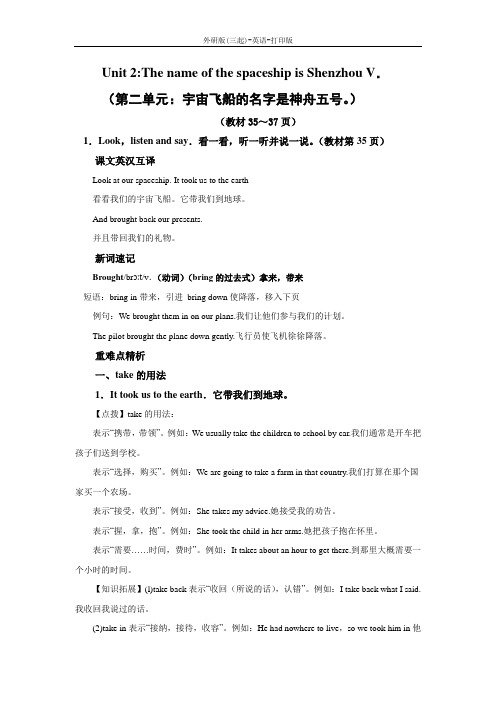
Unit 2:The name of the spaceship is Shenzhou V.(第二单元:宇宙飞船的名字是神舟五号。
)(教材35~37页)1.Look,listen and say.看一看,听一听并说一说。
(教材第35页)课文英汉互译Look at our spaceship. It took us to the earth看看我们的宇宙飞船。
它带我们到地球。
And brought back our presents.并且带回我们的礼物。
新词速记Brought/brɔːt/v.(动词)(bring的过去式)拿来,带来短语:bring in带来,引进bring down使降落,移入下页例句:We brought them in on our plans.我们让他们参与我们的计划。
The pilot brought the plane down gently.飞行员使飞机徐徐降落。
重难点精析一、take的用法1.It took us to the earth.它带我们到地球。
【点拨】take的用法:表示“携带,带领”。
例如:We usually take the children to school by car.我们通常是开车把孩子们送到学校。
表示“选择,购买”。
例如:We are going to take a farm in that country.我们打算在那个国家买一个农场。
表示“接受,收到”。
例如:She takes my advice.她接受我的劝告。
表示“握,拿,抱”。
例如:She took the child in her arms.她把孩子抱在怀里。
表示“需要……时间,费时”。
例如:It takes about an hour to get there.到那里大概需要一个小时的时间。
【知识拓展】(l)take back表示“收回(所说的话),认错”。
例如:I take back what I said.我收回我说过的话。
外研版(三起)-英语-三年级下册--Module 6 Unit 2 What does Lingling have at school- 教案
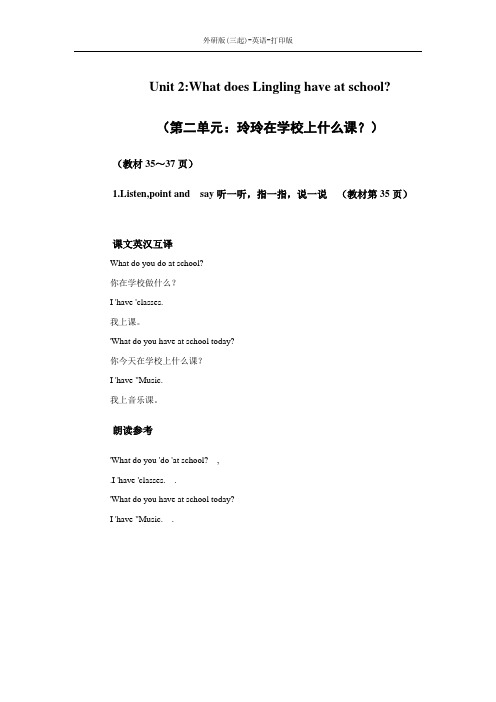
Unit 2:What does Lingling have at school?(第二单元:玲玲在学校上什么课?)(教材35~37页)1.Listen,point and say听一听,指一指,说一说(教材第35页)课文英汉互译What do you do at school?你在学校做什么?I 'have 'classes.我上课。
'What do you have at school today?你今天在学校上什么课?I 'have "Music.我上音乐课。
朗读参考'What do you 'do 'at school? ,.I 'have 'classes. .'What do you have at school today?I 'have "Music. .新词速记1.have/haev/v.(动词)上(……课),有短语:have classes上课have lunch吃午饭例句:I have Chinese,English and PE in the morning.上午我上语文、英语和体育课。
Do you have something to eat?你有什么可以吃的东西吗?拓展:have的第三人称单数形式为has2.today/t'de/adv.(副词)在今天:n(名词)今天短语:today's life今天的生活例句:They want to go to the zoo today.今天他们想去动物园。
What do you have at school today?你今天在学校上什么课?拓展:yesterday昨天,tomorrow明天3.music/‘mju:z k/n.(名词)音乐短语:listen to music听音乐music room音乐室例句:Tom likes music.汤姆喜欢音乐。
外研版(三起点)小学六年级英语上册Module6_Unit2_ 优课教案

Module6 Unit2 教学设计I’ve got a stamp from China.一、教学内容分析本模块的教学内容是谈论自己和他人拥有的物品。
本模块第二单元的任务是介绍自己和好朋友的异同,这项任务有助于学生更好地了解自己和他人。
第二单元的课文情境是Sam和Lingling互相提问:Sam问Lingling有没有刀叉和筷子,Lingling说两样都有;Lingling问Sam有没有中国风筝和日本风筝,Sam说两样都有;Sam问Lingling有没有介绍中国的书和介绍美国的书,Lingling 说她有介绍中国的书,但没有介绍美国的书;Lingling问Sam有没有中国邮票和加拿大邮票,Sam说他有中国邮票,但没有加拿大邮票。
二、教学目标(一)知识目标:1.100%的学生能听懂、会说、会认读单词:knife, fork, chopsticks, Japanese。
2. 90%的学生能够在情景中运用句型Have you got a book about the US? I’ve gota stamp from China.询问他人拥有的物品。
(二)技能目标:1. 90%学生能够在图片和教师的帮助下理解对话大意,能够根据正确的语音、语调、意群朗读对话;2. 大多数学生能够通过教师给出的思维导图,运用连接词“and”、“but”介绍自己与好朋友在语言、文化、家庭、爱好方面的异同。
(三)情感目标:了解不同国家的文化,弘扬中国优秀传统文化。
三、学情分析六年级已进入小学高年级阶段,他们活泼好动、思维活泼,有一定的自控能力。
抽象记忆有所发展,但思维活动形象记忆的作用仍非常明显,需要具体、形象的教材及灵活多样的教学方法来引导学习。
学生在三年级学过have got的运用,有一定的基础,教师可以引导学生归纳、总结已学的和前几个模块的句型,帮助学生逐步积累,进而达到掌握,将语言运用到实际生活中。
四、教学重点和难点五、教学环境设计(含多媒体教室、教具或教学材料)多媒体教室、优教班班通白板课件、单词卡片等。
Book6 unit1--2
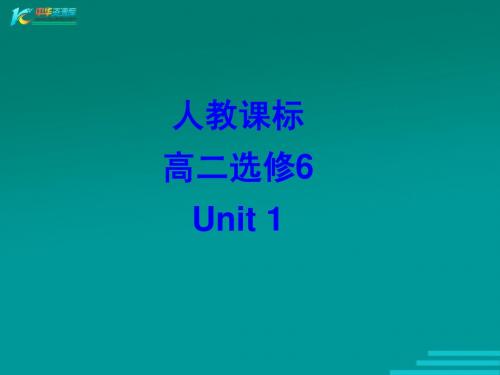
The Renaissance
15th~16th century
Pepole and 4. ___ nature
To show how7. _ light Characteristics:pain and shadow fell late 19th~early outdoors ters worked 8. __ on objects at 1. Impressionism ____ 20th century different times of and painted quickly day
First-reading: read the passage for the first time and answer the two questions.
1. What’s the main idea of the text? The style of Western art has changed a lot with time going by.
Masaccio的作品:
王 座 上 的 圣 母 圣 子 和 四 天 使
Madonna with Child and Angels
Crucifixion
耶稣钉刑图
凡高《向日葵》
Match the words with the correct meanings:
[A] a. realistic b. abstract [B] 1. lifelike, true to life 2. being in thought but having a physical or practical existence
2. _____ discovered how to make paintings look more real by using perspective. A. Giotto di Bondone B. Masaccio C. Claude Monet D. Pablo Picasso
